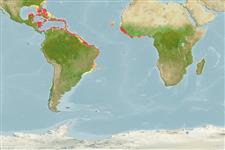Environment: milieu / climate zone / depth range / distribution range
Ecología
marino asociado a arrecife; rango de profundidad 0 - 100 m (Ref. 5979), usually 0 - 20 m (Ref. 40849). Tropical; 34°N - 25°S, 91°W - 5°E
Western Atlantic: Florida (USA), Bermuda, and the Bahamas to Brazil. Absent in Gulf of Mexico (Ref. 26938). Eastern Atlantic: Ascension Island and the Gulf of Guinea (Ref. 5979).
Tamaño / Peso / Age
Maturity: Lm ? range ? - ? cm
Max length : 46.0 cm TL macho / no sexado; (Ref. 5979); common length : 35.0 cm TL macho / no sexado; (Ref. 3275)
Radios blandos dorsales (total) : 92 - 99; Radios blandos anales: 71 - 76. Gray to brown with numerous circles, curved spots, and dots of light blue on head and body; fins with small light blue spots; two or three large diffuse blackish spots on straight portion of lateral line (Ref. 13442).
Inhabits clear sandy areas near mangroves, among seagrass, coral or rubble (Ref.9710). Most common flounder around coral reefs (Ref. 26938). Often partially buried in sand, occasionally on hard bottoms (Ref. 9710). Feeds mainly on small fishes but also on crustaceans and octopuses. Marketed fresh (Ref. 5217).
Life cycle and mating behavior
Madurez | Reproducción | Puesta | Huevos | Fecundidad | Larva
Robins, C.R. and G.C. Ray, 1986. A field guide to Atlantic coast fishes of North America. Houghton Mifflin Company, Boston, U.S.A. 354 p. (Ref. 7251)
IUCN Red List Status (Ref. 130435: Version 2024-1)
Threat to humans
Harmless
Human uses
Pesquerías: escaso valor comercial; Acuario: Comercial
Herramientas
Special reports
Download XML
Fuentes de Internet
Estimates based on models
Preferred temperature (Ref.
123201): 25.2 - 28, mean 27.3 °C (based on 368 cells).
Phylogenetic diversity index (Ref.
82804): PD
50 = 0.5000 [Uniqueness, from 0.5 = low to 2.0 = high].
Bayesian length-weight: a=0.01047 (0.00567 - 0.01934), b=3.08 (2.92 - 3.24), in cm total length, based on LWR estimates for this species & Genus-body shape (Ref.
93245).
Nivel trófico (Ref.
69278): 4.5 ±0.7 se; based on diet studies.
Resiliencia (Ref.
120179): Muy bajo, población duplicada en un tiempo mínimo superior a 14 años (Preliminary K or Fecundity.).
Fishing Vulnerability (Ref.
59153): Moderate vulnerability (36 of 100).
Nutrients (Ref.
124155): Calcium = 36.4 [14.1, 67.1] mg/100g; Iron = 0.475 [0.216, 0.877] mg/100g; Protein = 18.3 [16.8, 19.9] %; Omega3 = 0.0843 [, ] g/100g; Selenium = 35.7 [17.0, 81.7] μg/100g; VitaminA = 109 [26, 452] μg/100g; Zinc = 0.739 [0.471, 1.122] mg/100g (wet weight);
